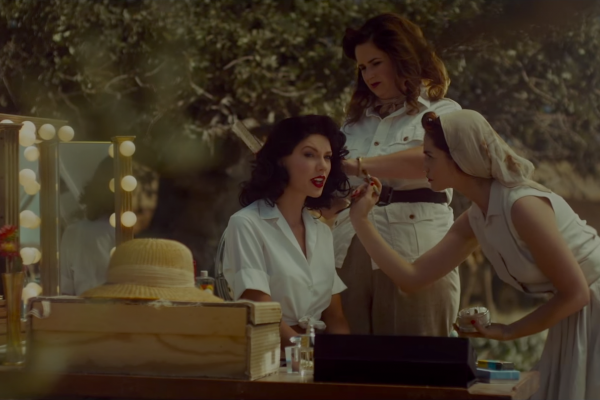Taylor Swift’s controversial new music video, “Wildest Dreams,” is intended as an ode to old Hollywood glamour. Set in the 1950s, it depicts the production of a film in an (unspecified) African country and a love affair between the film’s female and male leads. Ms. Swift, evoking old Hollywood actresses like Elizabeth Taylor and Katharine Hepburn, walks, flies, argues, and kisses her way through the African savannah, past giraffes and lions and wildebeest herds.
The music video is intended to evoke awe of the “wildest” of landscapes (all video sale proceeds go to the African Parks Foundation of America). These landscapes, of course, being the Africa that many American viewers remember from the movies and shows we watched as children: pure natural beauty, “undiscovered” and “untarnished” — and entirely without Africans.
Perhaps because this video launched soon after Ms. Swift’s recent race- and privilege-related feud with Nicki Minaj, or because at the time of writing, the video has reached nearly 25 million views since its release on Aug. 30, response to the video has been intense. Sources that would usually have no opinion on Taylor Swift’s music are suddenly up in arms. Opponents condemn the virtual non-presence of people of color on screen, and correctly point out the video’s racism and allusions to white colonialism in Africa. Proponents — including Joseph Kahn, the video’s director — respond that since the video is an homage to 1950s Hollywood, inclusion of more African-Americans and individuals of other races and ethnicities would be anachronistic. Additionally, they’ve pointed out that the producer, editor, and director of “Wildest Dreams” are people of color — thus declaring the issue of representation among top creatives behind the camera a non-issue.
Reading articles on both sides was a conflicting experience, as a young white woman raised on fashion magazines, classic cinema, and the idealization of “old Hollywood.” White privilege was not a concept I understood, or absorbed, until I was in my late teens. Before then, I never noticed the lack of people of color in most of my preferred media. Nothing seemed amiss when I skimmed catalogs and magazines rife with white women posing in vintage haute couture, surrounded by African or South American scenery, or wearing high-fashion variants on “safari gear” in the jungle, or holding a jaguar in a diamond-studded collar.
We as a culture have come to adore films like The African Queen — one of the inspirations for “Wildest Dreams,” and itself a widely-acclaimed work — despite their inherent racism and misogyny present. We may excuse their biases in the same way defenders and creators have excused “Wildest Dreams” — namely, that they are a product of an oppressive time, and therefore cannot help their inherent oppressive message. But can we love and appreciate those films without endorsing that oppression? Is it possible to create an homage to them without endorsing them entirely?
In short — how can we free ourselves from the cognitive dissonance of outwardly condemning racism, misogyny, and colonialism while still internally glorifying images and ideals that are built upon them?
The answer to this question may lie in other, more nuanced, portrayals of midcentury American culture. The critically-acclaimed Mad Men, which depicted the American advertising industry in the 1960s, was known for its impressive art direction and meticulous attention to historical detail. It glorfied 1960s fashion, which experienced a revival soon after the show aired.
As in “Wildest Dreams,” the only non-white characters in Mad Men are exactly where they would have been found in the 1960s white business world — on the periphery. And the creator of Mad Men, Matthew Weiner, has made similar arguments to “Dreams” director Kahn for the black (non-)representation in his series.
But Mad Men could not be accused of glorifying any of its subject material, or glamorizing the morally questionable. Despite its material glamor, the lives of its characters are interesting but repugnant, exciting but cruel. When black characters appear on screen in Mad Men, they are not afterthoughts or barely-visible, as is the case in “Dreams.” Even when their characters are not fully developed, characters of color in Mad Mendraw attention to the institutionalized racism of the time, just as the female characters draw attention to its inescapable misogyny.
Nearly every scene in which Hollis, the elevator operator at Sterling Cooper, is present, is a prime example. In one episode, Sterling Cooper copywriter Paul Kinsey attempts to impress his black girlfriend by, for once, treating Hollis with a modicum of humanity.
Through interactions like this, viewers are to able see this predominantly white and privileged world in context, as a reminder of the oppressive, violent, and exclusive bubble in which the protagonists live. Viewers could — and in my case, did — end each episode with no desire to return to the “good old days” — and in fact, with really no concept of there being such a thing as the “good old days” at all.
Mad Men, unlike “Wildest Dreams,” was able to portray glamorous, vintage fashion without endorsing the oppression that came with it. Taylor Swift and the creators of her most recent video could learn from this example. Fashion can be celebrated without oppression. Glamour can be inclusive. And not just in our wildest dreams.
Got something to say about what you're reading? We value your feedback!

